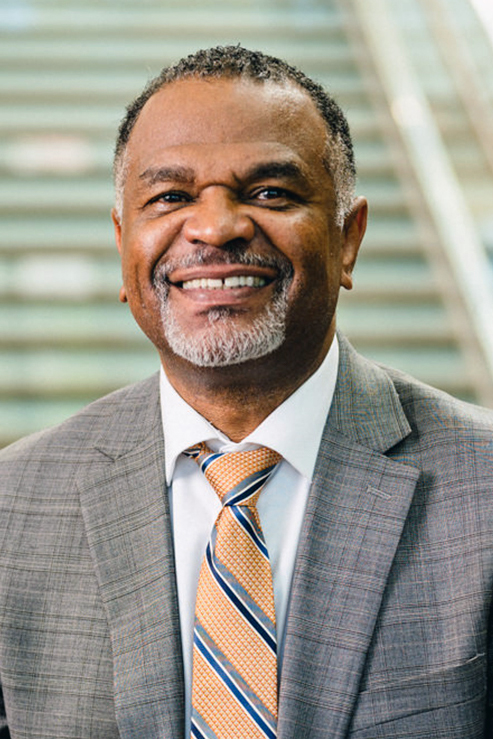One U PeopleSoft Finance Transformation
Project update: The ‘why’ and where we are now

Image courtesy of the University of Utah.

Martell Teasley, interim senior vice president for academic affairs
It’s been more than a year since the kickoff of the One U PeopleSoft Finance Transformation Project, a multiyear endeavor with three main objectives: redesign the general ledger chart of accounts (COA), reduce finance customizations in the University of Utah’s instance of Oracle PeopleSoft, and improve finance reporting capabilities across the institution.
“The need to streamline and modernize our processes and sustain them over time is paramount to where we’re headed as a university,” Martell Teasley, Ph.D., interim senior vice president for academic affairs, said during a project advisory meeting August 26.
In this article, project stakeholders revisit the “why,” celebrate recent milestones, and dispel some common misconceptions.
Why is the U undertaking this project?
Advisory committee
We encourage you to contact your organization’s representative(s) if you would like to receive project-related news or provide feedback.
- Rob Allen, Property Accounting
- Kris Arko, Hospital HR
- Becca Baggett, OBIA
- Jennifer Aoyagi Bangerter, College of Pharmacy
- Jerry Basford, Student Affairs
- Aaron Bell, Internal Medicine
- Brent Brown, Office of Sponsored Projects
- Kevin Cheney, Huntsman Cancer Institute
- Jason Cryan, Natural History Museum of Utah
- Nate Dickson, U Faculty Information & Support
- Kirsten Dorius, Advancement
- Doug Finlinson, Health Plans Finance
- Sandy Hughes, Budget and Analysis
- Michael Kay, College of Engineering
- Josna Kotturappa, HR/Payroll
- Tony Millett, Natural History Museum of Utah
- Wendy Petersen, Human Resources
- Rochelle Randazzo, Facilities
- Jenn Reed, Auxiliary Services
- Clint Reid, Hospitals and Clinics
- Donna Roach, U of U Health Chief Information Officer
- Sara Sherer, Hospital HR
- Katelyn Thompson, Hospital HR
- Matt Thomson, Athletics
- Bryan Webster, Pathology Department
- Amanda White, Hospital HR
Key project goals fall into three general categories: COA redesign, PeopleSoft Finance optimization, and reporting.
COA redesign
- Redesigning the COA will create a more efficient system to process transactions, support management reporting, and generate analytics.
- A central, flexible, and scalable COA will improve financial reporting for departments, colleges, schools, divisions, and business units, while continuing to enable external financial reporting.
- The redesign will position the U to implement new enterprise resource planning (ERP) software that will provide better controls, data, and audit documentation.
“The lack of standardization across business units makes it really difficult for those managing areas that cross the institution to prepare analyses and reports for leaders in a timely manner,” added Theresa Ashman, associate vice president for Financial and Business Services. “Many universities have moved toward more frequent — in some cases, monthly — financial reporting on a [generally accepted accounting principles (GAAP)] or near-GAAP basis. While our hospitals and clinics prepare monthly reports, the U as a whole prepares only one annual financial statement that takes almost four months to complete. Moving toward more frequent financial reporting is imminent, and we need to be prepared to support this. Without this project, we simply can’t do it.”
PeopleSoft Finance optimization
- The U hasn’t been able to take full advantage of Oracle’s functionality improvements due to hundreds of customizations over the past two decades.
- Customizations are expensive and increase the time and effort required to implement upgrades and patches. Other changes, like reorganizing or adopting new chartfield accounts, are also made more complex because of customizations.
- This project entails researching, identifying, and recommending possible key improvements to leverage current up-to-date applications.
“We will create greater financial transparency through the elimination of shadow systems and using PeopleSoft for all transactions,” said Ken Pink, deputy chief information officer for University Information Technology (UIT). “Mitigating Peoplesoft customizations also reduces maintenance and increases flexibility.”
“Customizations have really tied our hands in terms of growth and frankly made things much harder than they need to be,” Ashman added, noting that the U’s Asia Campus, which uses QuickBooks, would “logically be part of a PeopleSoft implementation, but right now we can’t even consider it due to the complexities of adding another business unit that needs to be predicated on a foreign currency.”
Reporting
- Modern reporting capabilities are crucial to support U of U and U of U Health strategic plans.
- This project will improve financial transaction transparency.
“Better reporting capabilities allow for more data-driven management decisions,” said U of U Controller Steven Phillips.
The big picture: Accommodating for growth
More generally, the project is tied to the success of the U’s Strategy 2025, particularly, “consolidate, develop and refresh technologies and centralize data and analytics to better serve our constituents.”
“The U isn’t the same institution it was in 2000 when PeopleSoft was implemented — in terms of staff, research, administration, patient population, organizations, and complexity,” said Piotr Pawlikowski, senior IT project manager in UIT’s Project Management Office.
Here are some numbers to back that up.
University of Utah financial growth (data courtesy of Theresa Ashman, associate VP for FBS)
In 2001:
- The U employed 10,528 staff members and enrolled 27,668 students; in 2022, those numbers increased to 30,089 staff (+185%) and 34,424 students (+24%)
- Total revenue was $1.69B; in 2022, it was $6.86B (+304%)
- Total assets were $2.62B; in 2022, they were $9.83B (+275%)
- Endowment assets were $297M; in 2022, they were $1.36B (+142%)
- Research dollars were $242M; in 2022, they were $641M (+165%)
University of Utah Health operational growth (data courtesy of Karen Macon, controller for University Hospitals and Clinics)
In 2000:
- Approximately 19,004 patients were admitted to the U of U Health; in 2022, that number rose to 34,254 (+80%)
- U of U Health had 421 patient beds; as of 2022, it has 782 (+86%)
- ~417,000 patients visited U hospitals and clinics; in 2022, that number jumped to 1.48M (+355%)
... and in 20 years, these numbers are expected to rise even more.
“To accommodate goals for growth in student body, research, endowment, and so on, we need a more flexible system that can handle situations as they arise, such as new business opportunities,” Phillips said.
Recent project accomplishments
- A preliminary draft of a new Chart of Accounts was completed
- The General Ledger/COA project team continues phase 2 activities such as gathering feedback from U of U Health and main campus stakeholders and users
- An Elire tool was purchased, and Elire consulting services were leveraged to enable
the university to:
- Identify unnecessary PeopleSoft customizations
- Make recommendations on which U customizations to keep or remove
- The project’s advisory committee was rechartered and relaunched
- An Enterprise Data Management (EDM) tool is ready for configuration
- eJournal functionality in PeopleSoft is under development
- Bank reconciliation functionality in PeopleSoft has been configured
- Current tools within PeopleSoft, e.g., fluid pages, work centers, and activity guides, have been adopted
Misconceptions and myths about the project
“This is a hospital (U of U Health) project, not a main campus project. Main campus doesn’t need to be involved.”
Fact: It’s crucial for main campus and U Health units to join together in decision-making so all needs can be met. Everybody must be well informed, deeply involved, and collaborate at every phase of the project. Project outcomes will benefit both organizations and the larger institution.
“This project was caused by the Business Unit 06 project. If we didn’t have to go through that project, we wouldn’t need to deal with the One U PeopleSoft Finance Transformation project.”
Fact: BU06 highlighted the underlying shortcomings of our current system. It was not the cause.
“The cost to update integrated systems and tools will far outweigh the benefits” (i.e., integrations with third party tools, HR module, etc.).
Fact: The cost for this change is the proverbial “can kicked down the road” from when the U originally implemented PeopleSoft more than 20 years ago. We are a very different institution now than we were then and are on a trajectory to grow and change even more. Yes, it is a cost, but it is a necessary cost to support the U of today and the U of the future.
Additional resources
Node 4
Our monthly newsletter includes news from UIT and other campus/ University of Utah Health IT organizations, features about UIT employees, IT governance news, and various announcements and updates.
